Welcome, Trash Hero!
Thank you for joining us.
Are you ready to change the world?
Our actions inspire others to care for the environment and to change their habits.
This change can spread to whole communities and societies so that ultimately, we can all live in a clean world, free from plastic pollution.
Now we are going to show you how…
CONTENTS
Introduction
1. Build a team
2. Create marketing materials
3. Set up a cleanup programme
– Where does the trash go?
– True and false solutions for waste
4. Set up a bottle refill programme
5. Set up a reusable bags programme
6. Involve kids
7. Engage the wider community
8. Use social and traditional media
9. Get sponsors
10. Manage volunteers
11. Don’t give up!
12. Support the wider Trash Hero mission
Text by Jan Bareš, Petra Essenfelder, Roman Peter, Seema Prabhu, with input from volunteers worldwide
Last updated: October 2020
Introduction
TRASH HERO: Inspiring action on waste
Trash Hero is a global movement, run by volunteers.
Our mission is to bring communities together to clean and prevent waste – and ultimately to create a world without trash.
Founded in Thailand in 2013, we are now active in 170+ locations worldwide through a network of local chapters and country organisations.
The global coordination body is registered in Switzerland as Trash Hero World, a non-profit association.
What we do
We have three core programmes, all of which are delivered by volunteers:
 Cleanups
Cleanups
We organise weekly events where we pick up trash, inviting and motivating people to become Trash Heroes.
 Reusable Bottles & Bags
Reusable Bottles & Bags
We provide stainless steel bottles to local businesses at cost. The businesses sell the bottles for a small profit and offer free water refills in return. In addition, we produce reusable shopping bags, and provide them at cost to local businesses for their guests and clients.
 Education & Kids
Education & Kids
We have our own kids’ story book with challenges and rewards, and we visit schools and run workshops to increase awareness and show simple solutions to environmental problems.
How we do it
The Trash Hero approach is based on the five following principles:
- Be positive: we focus on solutions (not problems), the future (not the past) and on what is going well (not what is wrong or who is to blame).
- Be inclusive and neutral: we work independently, bringing communities together for one mission that benefits all.
- Show, don’t tell. Repeat: we lead by example, taking small easy steps which, when multiplied, can result in great change. With regular actions, the change becomes lasting.
- Think global, act local: our local chapters are the life-force of our movement. Trash Hero World provides training, materials and a global platform to amplify their voices.
- No money: our local chapters don’t take or make money through their activities. Expenses are covered by donations in kind (goods and services) from local sponsors, and any products are sold at cost, with publicly available receipts.
What does a Trash Hero chapter do?
Our local chapters take the Trash Hero mission and approach to their communities. They may run any or all of the projects listed above, with regular cleanups or a bottle programme as a minimum.
This handbook will take you through the main points of how to set up and run a successful chapter.
“By changing the way we live our lives, we can contribute to our own survival and well-being and ultimately that of the planet.”
Jeremy Irons, Executive Producer of “Trashed”
1. Build a team
 A good team is essential to the success of your chapter. It should have a minimum of three people, and include at least one person who is well-connected to the local community. The optimal size is 5 – 6 people.
A good team is essential to the success of your chapter. It should have a minimum of three people, and include at least one person who is well-connected to the local community. The optimal size is 5 – 6 people.
Your team does not have to come from people you already know: ask around, or post on social media to see if anyone else is interested in helping.
Look for people with a positive attitude, energy, respect for the local culture and (if possible) able to commit a few hours a week long-term. Note: If you are under 18, you will need an adult in your team.
Nobody needs to be a specialist in anything and our mentor team can help you to improve your skills.
Your team will be covering a range of tasks every week:
Planning: Organise your activities and programmes, including delivering equipment for the cleanup events, and arranging transportation for the trash, and (if needed) people.
Communication: Answer emails, messages and calls; post events and updates on social media; represent Trash Hero to the general public and media. This might be, for example, leading a briefing session at a cleanup, or giving an interview on local TV.
Translation: Make sure all social media posts, and any other texts created by your chapter are available in both local language and English. We can provide general texts (such as this one) in both languages for you.
Involving the community: Inform local businesses about your activities and ask them for support – for example, by hanging up a poster or providing materials or services that you need. Talk to local authorities, schools and other community groups about your project.
Sharing your story: Take photos and videos to show what you are doing and inspire others to take action. These can be posted on social media, with some text in local language and English. If you have design / editing skills or professional equipment, that’s great – but most important is that you have a regular supply of positive pictures and videos to post.
There is no fixed way to handle these tasks. Some tasks can be done by more than one team member; or one team member can do multiple tasks. Tasks can also be broken down into smaller jobs. It depends on the size of your team, the people, and the time they have available.
It’s helpful to have an online chat group (Messenger, WhatsApp or Line) for your team to keep each other updated and motivated. Have regular meetings outside of events to make sure everyone is focused and happy.
Be open to inviting new members to join your team and give them small tasks to help. For example a new team member could help you two hours per week to translate text for Facebook posts. The team can grow very organically like this.
If you need to leave your team, give as much notice as possible. Even better, help them to find and train someone else to take over your tasks.
Share your chapter’s successes with all of your team – no one person should take personal credit, in private or public. Show appreciation for each other, celebrate together and your chapter will only grow stronger.
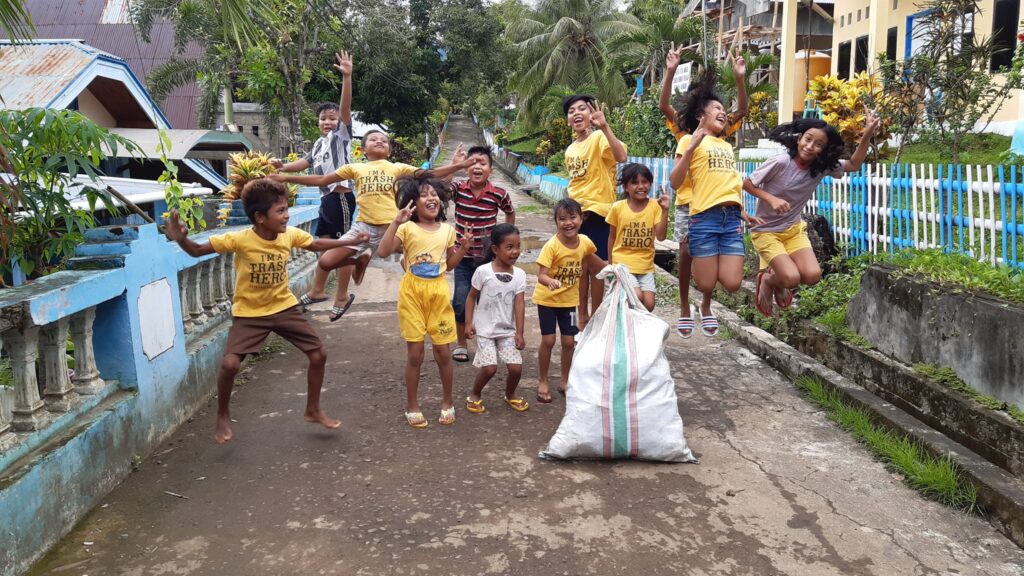
“Anyone can be a Trash Hero!”
Our strength lies in being inclusive and open to all: a shared love of our planet and its future overcomes any differences between us.
2. Create marketing materials
Overview
The Trash Hero brand is something we have worked hard to create. Our brand consists of our name and our logo (which are trademarked worldwide), but also our colours, our design values and our message. It represents who we are and what we stand for. It’s important that we protect how it is used and that it is used consistently everywhere.
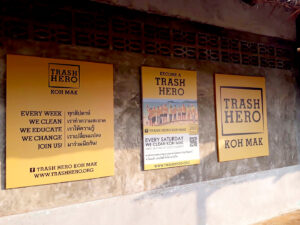 So we have a set of guidelines for using our logo, colours and fonts, as well as a set of templates to use for all main marketing materials. You can request access to these once your chapter is set up.
So we have a set of guidelines for using our logo, colours and fonts, as well as a set of templates to use for all main marketing materials. You can request access to these once your chapter is set up.
If you have any new ideas for marketing materials, or need help to customise the templates, our design team can also help you. Please understand they are volunteers like you, so they may need some time to complete your request. If you would like to create any new marketing materials yourself, check with them first before printing or publishing.
1. Chapter logo
When you start a chapter, we will give you a Facebook page, using a Trash Hero logo on a white background, with your chapter name. The white colour shows you are in the startup phase.
After completing a trial period – usually around 10 cleanups – you will be able to use the yellow logo and have your chapter page listed on our website.
Both white and yellow logos should be used according to our brand guidelines.
2. T-shirts
When you start your chapter, if you are in a country where Trash Hero is already present, we will provide up to five t-shirts for your core team. If you are the first Trash Hero chapter in your country, you may have to wait a little longer as we won’t have any supply ready for this.
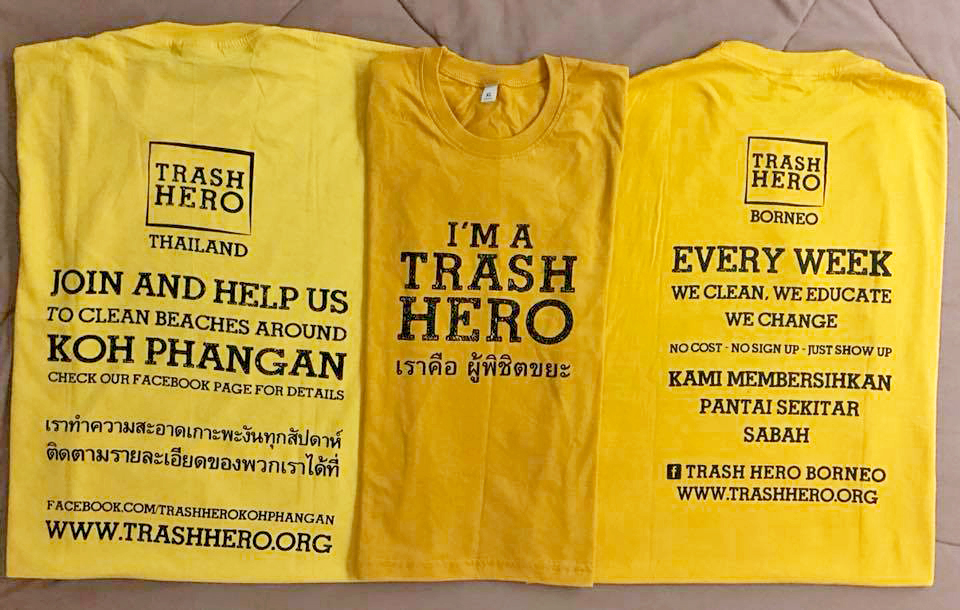
What is a Trash Hero t-shirt?
Trash Hero t-shirts are the main symbol of our movement. They are yellow and have the words “I’m a Trash Hero” in English on the front, as below. They also have the local translation of the words underneath this. The back of the shirt varies, but should always have our logo, website address, and social media handle.
The t-shirt can never have any third party names or logos on it because we need to stay neutral, nor can our logo appear on anyone else’s shirts.
To get a t-shirt design for your chapter, please contact Trash Hero World or your country coordinator.
Printing the t-shirts
We recommend that you make your first chapter-branded t-shirt order after you get your yellow logo. Try to get local sponsorship to fund this: it’s a great way to involve local businesses in your activities (see: Get Sponsors).
Print your t-shirts locally if possible, to develop good relationships within your area. The printer should have the same yellow colour shirts that we use, in 100% cotton or other natural material.
Check their minimum order number, and compare prices / quotes with other printers if you can. If you are not able to find a local printer, your country organisation may have contacts to help you.
Please note: get an invoice with your chapter name and transfer the payment directly to the printing company. You will need this invoice and receipt to show to your sponsors, and later when you sell the shirts. Always ensure Trash Hero is 100% transparent.
Trash Hero World will also, within a year of stable operation, provide some free t-shirts to your chapter.
Selling the t-shirts
Trash Hero t-shirts are sold at cost price, or given away for free.The cost price can include your delivery charges if not printed locally.
Keep the receipts from the printing company and delivery service and publish them on social media to show that you are not making any profit.
Money received from Trash Hero t-shirts should be kept and used to print a new order of t-shirts, not for any other purpose. This gives your chapter a sustainable supply of t-shirts.
Some chapters may wish to sell the t-shirts via third parties such as dive shops or hotels. Again, sell them to these places for cost price only, and keep the receipt to show this. Trash Hero does not set any selling price for the third parties.
3. Other materials
There are other kinds of marketing material you might find useful for your chapter. These include:
- posters: to advertise your cleanup or refill programme in local restaurants, shops, hotels etc.
- banners or flags: to have at your events and use in photos
- stickers
- flyers
- business cards
Not all of these will be necessary or appropriate, depending on your location.
Again, the design team will be able to help you. If you would prefer to do your own design, please follow the brand guidelines and send any material to the design team to check before printing.
Try to print locally: some shops may be happy to give discounts or even free printing to organisations such as Trash Hero (it never hurts to ask!). Or, find other sponsors to cover the cost.
Consider the materials you use: recycled paper and cotton fabric are better than vinyl, polyester or plastic coated boards.
3. Set up a cleanup programme
Trash Hero chapters do weekly cleanups. This creates constant awareness of plastic pollution in your community and lays the ground for behavioural change. Cleanups also allow us to collect data that can be used by scientists and campaigners to influence big companies and governments to “turn off the plastic tap.”
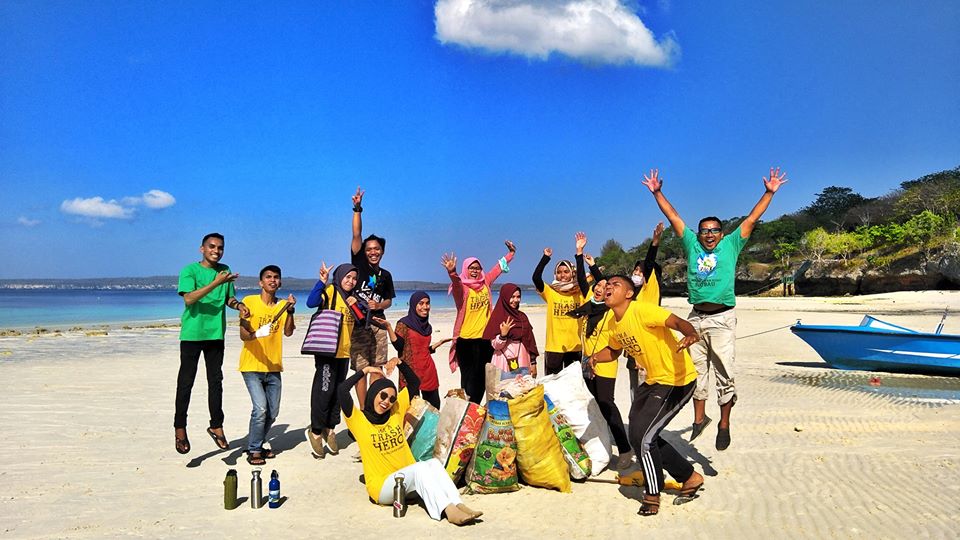
Where to clean?
In some areas, trash is easy to find. If you are near a beach or public park, this is a good place to start; avoid busy roadsides or other places that might be dangerous for your volunteers.
Some countries are very clean and you do not see much trash. If this is the case, go for a walk, ask residents, or use a trash mapping app (e.g. TrashOut). Cigarette butts and small pieces of plastic are just as important to pick up as discarded fishing nets and giant foam boxes.
Important: we clean up trash in public spaces. We do not clean trash on private premises.
Legal considerations
Different countries have different regulations for handling trash, and you will need to respect these. Before you start any cleanup, contact your local government and ask permission to do a cleanup in their area. This applies to all countries. In some western countries this is required by law.
Set a day and time
Choose a day of the week and time of the day that will suit your team and the people in your area.
For example: every Sunday at 4pm
If you are not sure which day or time is the best, ask residents about their opinion. Also consider the weather: in some countries it can get very hot in the mid-afternoon.
Note: it can be a challenge to organise weekly cleanups. If your team is struggling, be patient. Start with less frequent cleanups and work towards the goal of cleaning on weekly basis. Once you get experienced and the team grows, this should become manageable.
Set a meeting point
Depending on your area, from week to week you might clean up at the same place or change the location each time. This brings two different strategies into the game:
“Fixed meeting point”: this is very handy to have if you are on a small island, or if you clean the same area every week (e.g. one beach). It makes it easy for people to find the location and it works well with posters and other advertising, for example: “Join us every Monday at 3pm at Batu Bolong beach”.
“Check Facebook for location”: if you change cleanup location every week, you’ll need to inform people through social media where the next cleanup is. Make an event on your Facebook page and invite everyone (see: Use social media). Your cleanup posters would then say: “We clean Batu Bolong every Monday at 3pm. Check our Facebook page for location.”
Regardless of which strategy you choose, the day and time of the cleanup should always stay the same every week, and all meeting points should be neutral (e.g. beach, statue, street, train station), not promoting any business (e.g. Green Hostel, Hippo Bar, Marco’s Pizza)!
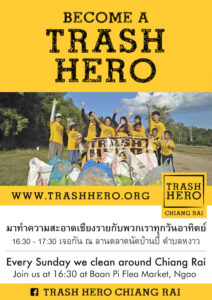 Inform people about your cleanups
Inform people about your cleanups
There are many different ways to get people to participate:
- Word of mouth: talk to people!
- Posters: get them done by our design team, have them printed by local printer, hang them indoors in supportive businesses (outdoor posters usually have a short life)
- Social media: post on your chapter’s Facebook page (and other channels) and in local groups (see: Use social media)
- Trash Hero t-shirts: the back of the t-shirts can promote your cleanup (see: Marketing materials)
- Invitations: personally invite hotels or other businesses to come along with their staff
Make sure all details of the cleanup are included: date, time and place; and that people know they can just turn up. We use the slogan: “No cost, no sign-up, just show up!”.
What to organise before a cleanup
Materials & supplies
Essential:
- Gloves (use washable, durable gloves, not single use plastic gloves)
- Bags (prefer reusable bags – e.g. rice bags – not single use plastic bags)
- First aid kit
Nice to have:
- Water* from a reusable tank (not plastic bottles) and zero waste snacks (e.g. bananas, not individually wrapped cookies) for volunteers
- Scale (to measure the weight of the trash you collect)
- Tools (in some areas, litter picks, rakes, knives or shovels might be handy)
- Your Trash Hero chapter banner or flag (it looks great on pictures)
- Paper tape and a marker pen to tag your bags and write on them what is inside (this is helpful for the recycling station that will receive the bags later)
*Whether you provide water refills or not, always remind people to bring their own water bottle with them to the cleanup – we don’t want our volunteers to get dehydrated!
People & planning
For the first few times, have at least two cleanup leaders present from your team. Tasks will include briefing, taking pictures, weighing the bags etc. Later, regular volunteers can help you with these.
Organise your trash pick up
This could be a collection from your local waste management services, or delivery to a recycling plant / an authorised dumpsite. See: Where does the trash go?)
Transport
Generally people are expected to come by themselves to the cleanup, but if, for example, you want to clean up a remote area or island, you will need to provide transport for volunteers there and back from the meeting point.
How to organise supplies, trash pick-up or transport
Ideally, all of these things can be provided by your local community. If the community works together, everyone shares the credit for the great results.
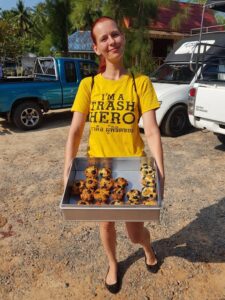 There are many possible ways of cooperation: local area businesses or the municipality could provide tools and cleaning materials; trash bag collection can done by local waste services; restaurants or hotels can give water or food for volunteers; a local laundry can wash the gloves etc. See also: Get sponsors.
There are many possible ways of cooperation: local area businesses or the municipality could provide tools and cleaning materials; trash bag collection can done by local waste services; restaurants or hotels can give water or food for volunteers; a local laundry can wash the gloves etc. See also: Get sponsors.
The idea is that everyone can be part of Trash Hero and contribute something. It is a small expense and great advertising for all the businesses. We always thank all sponsors publicly for their help at the cleanup and later again on our social media channels.
It is important to get as many businesses involved as possible, with different sponsors each week. Be creative! For example, a massage shop could give you vouchers for a free massage to offer as a prize for volunteers. If many different sponsors (large and small) are helping, the community knows that Trash Hero is a neutral project for the benefit of all.
Note: it’s very important to accept only “in kind” donations (this means goods and services, no money). For example, if you need gloves, ask for gloves. Sometimes the business will prefer to give you money. In this case, go to buy the gloves yourself first, and take the receipt to the sponsor to collect the exact money back. Giving the receipt to your sponsor makes everything 100% transparent and everyone can be sure that the Trash Hero chapter does not make any money through the donations.
On the day: a typical cleanup plan
Have the following points clear among your team before you start – you’ll need to communicate them to your volunteers on the day.
- Clearly define your start and end times (usually a cleanup will last 1-2 hours)
- Clearly define the area of cleanup (from “here” to “there”)
- Clearly define your final meeting point (where to bring the bags) and what time to be there for the final picture
- Plan to separate the trash from the start, rather than emptying bags and sorting at the end. Separation is easier if you assign volunteers to pick up certain kinds of trash and people walk in teams (e.g. the “glass heroes” or the “PET bottle heroes”). If you are collecting data, you may wish to assign a “brand audit” team.
- Ensure people do not overfill the bags, as they will need to be tied and closed
- Know who will be at the final meeting point to weigh full bags and report the numbers
- Know who will be at the start point in case of latecomers
- Know who will take pictures / videos throughout the cleanup. Ask people first if you can take their photo: it is important to get permission, and you will also get a better shot as they will stop and look at the camera.
Schedule of the cleanup
Be at the location a few minutes ahead of time to wait for your volunteers. Take a few “before” photos. Have a Trash Hero flag or wear your yellow t-shirt to be visible. Smile, say hello to everyone and wait a few minutes for latecomers.
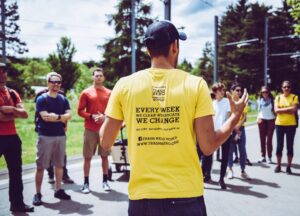 Do a briefing: welcome everyone and thank them for coming. Introduce Trash Hero briefly, and explain its mission and organisation. Explain the plan for today (see the points above). Remind people to have fun, take breaks, drink water and that every piece collected counts. If you have Trash Hero t-shirts available, now is a good time to mention they are for sale at cost price, so that new volunteers can wear them during the cleanup (and you have more yellow on the pictures!).
Do a briefing: welcome everyone and thank them for coming. Introduce Trash Hero briefly, and explain its mission and organisation. Explain the plan for today (see the points above). Remind people to have fun, take breaks, drink water and that every piece collected counts. If you have Trash Hero t-shirts available, now is a good time to mention they are for sale at cost price, so that new volunteers can wear them during the cleanup (and you have more yellow on the pictures!).
End of the cleanup:
- Take “after” photos (at the same spots as the “before” photos)
- Get the group together and take a happy final picture with all the trash bags
- Do a debriefing:
– Thank all volunteers for their help
– Thank all the sponsors and mention them by name
– Tell everyone how much trash you collected and where it – and the data – is going
– Mention other local Trash Hero projects that you are running (e.g. bottles, bags, kids…), and let them know how they can get involved
– Inform the group that you are going to post pictures on social media (ask their permission to do so) and ask them to tag themselves and share the pictures on their profiles - Collect email addresses of volunteers who would like to stay in touch with Trash Hero
- Go and celebrate! (it is nice to have sponsored food, drink or some after-cleanup fun activity)
After the cleanup
Take a break! Then, get ready to share your success on social media. Aim to do this on the same day, or the next, depending on your time and energy levels.
Posting checklist:
- Go through all your photos and choose the best ones (edit them a bit, if you can)
- Put together any “before & after” pictures
- Create a new Album on your chapter’s Facebook page for every cleanup (Photos > Add Album).
- Write the Title of the Album in the following format: Chapter Name – Cleanup number – Date – No. of volunteers – Amount of trash collected (in English).
- Write the Description of the Album and include:
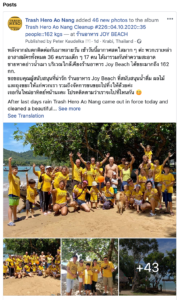 – date of the cleanup
– date of the cleanup
– location of the cleanup
– how many people in total joined. Include your team and any kids in this number. Then write the number of kids again separately. For example, you had 20 adults and 5 kids joining. You write: “25 volunteers, including 5 kids.”
– how many kg of trash you collected and how much was sent for recycling (if any)
– thanks to each sponsor you had for this cleanup
– “We do this every week.” or “See you next Sunday!”
– the website address www.trashhero.org - Set the Album location to the cleanup place
- Upload your pictures and drag them into the order you like
- Copy and paste the Album Description into every photo. If individual photos are shared, then it is easy to see what they are about.
- Add any other caption you need for specific photos under this description
- Tag people on the pictures (if you can)
- Do a final check, and publish!
Note: it’s a great idea to share your chapter’s posts, or your selfies from the cleanup on your private profile, but don’t use this as the main place to show your work. Always use the page, as it’s easily found and seen by everyone.
Did you have a really good cleanup, or other special event? Message your national Trash Hero page and Trash Hero World so we can share it or feature it as a blog post!
You will also need to report your numbers, if you didn’t already do that at the cleanup. Use the handy Trash Hero data collection form (links below), which you can add to your phone or bookmark in your browser. A how-to video here shows you the steps involved. Every so often try to update your Facebook cover picture with a new group photo and your chapter’s current totals (cleanups, volunteers, kids, kg of trash collected).
Data form – Czech Republic chapters
Data form – Indonesian chapters
Data form – Malaysian chapters
Data form – Myanmar chapters
Data form – Swiss chapters
Data form – Thai chapters
Data form – All other chapters
Remember, we count all the participants at each event. If a volunteer or team member joins you regularly, they count as one person each time. For example, a team of four people who do 10 cleanups will be counted as “40 volunteers” in the total numbers.
And that’s about it for cleanups. If you managed to do it all, you are awesome! Take a rest and celebrate with your friends and fellow heroes. This is a very important part. Enjoy it. You’ve done a good thing for the world.
Once you are rested, it’s time to get going again. Plan your next cleanup, wash your gloves, make an Event on your Facebook page and invite everyone! It gets easier every time, we promise.
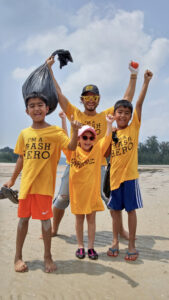
Note: When posting on social media, share only positive and inspiring messages. You want people to comment with thumbs up and hearts, not with angry faces and tears. We never blame and shame anyone for littering (even if we know who did it). We are Trash Hero, not the Trash Police. We share the message of awesome people doing awesome things for the environment.
WHERE DOES THE TRASH GO?
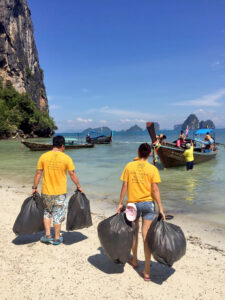 This is the question that people ask at almost every Trash Hero cleanup. The answer will depend on your location and the waste disposal system in place.
This is the question that people ask at almost every Trash Hero cleanup. The answer will depend on your location and the waste disposal system in place.
Whenever possible, we separate the collected trash and pass along the recyclable waste to local recycling facilities. Clean paper, glass and metal are essential to recycle, as these are “closed loop” materials (they can be recycled indefinitely without significant loss of quality). Plastic recycling is usually “open loop” (used to make lower-grade products with limited reuse, before eventually ending up in landfill), but it is still worth doing as a last resort for trash that we find.
It is also possible to “upcycle” plastic into ecobricks, paddle boards and other useful items. This keeps it in its existing form and requires no extra resources.
Many of our chapters have come up with creative ideas to reuse the trash they find. Here are some examples to inspire you – if you come up with your own, let us know and we can share it with the rest of the movement.
Trash Hero Komodo uses a “PET shredder” machine, in cooperation with a local community service, to turn collected bottles into flakes. Shredded plastic is a more valuable raw material for recycling companies. The PET flakes are stored in bags and shipped to recycling companies every time they reach 5000kg.
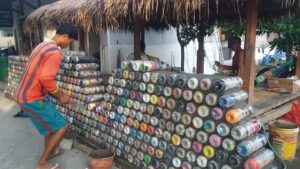 Many Trash Hero chapters in Malaysia, Thailand and Indonesia upcycle soft plastic waste and PET bottles to make ecobricks (www.ecobricks.org), a solid and versatile construction material that can be used to build indoor or outdoor furniture, shelters and houses.
Many Trash Hero chapters in Malaysia, Thailand and Indonesia upcycle soft plastic waste and PET bottles to make ecobricks (www.ecobricks.org), a solid and versatile construction material that can be used to build indoor or outdoor furniture, shelters and houses.
Trash Hero Thailand chapters donated their ecobricks to Bamboo School, a children’s refuge on the border of Thailand and Myanmar, where they were used to construct new school buildings. Chapters in Thailand also pass collected straws on to local NGOs who cut them up and use them to stuff pillows for wheelchair users.
Trash Hero Gili Meno gives a lot of trash to the Brotherhood collective where they upcycle it, making art, jewellery, glasses out of glass bottles and all sorts of other things.Trash Hero Koh Lanta has made bean bags out of collected Styrofoam.
 Trash Hero Bangkok, in conjunction with The Whale Company, made paddle boards out of single use plastic bottles. Trash Hero Thailand collects flip-flops to be shredded and reformed into new flip-flops, other shoes and gym mats by social enterprise company, Tlejourn. You’ll find many more collaborative projects with other organisations on our website.
Trash Hero Bangkok, in conjunction with The Whale Company, made paddle boards out of single use plastic bottles. Trash Hero Thailand collects flip-flops to be shredded and reformed into new flip-flops, other shoes and gym mats by social enterprise company, Tlejourn. You’ll find many more collaborative projects with other organisations on our website.
Despite all these efforts and interesting possibilities, a certain amount of collected trash will still end up in the landfill, or worse, incinerated – showing that trash never really goes “away” once it is produced. It can only go to a “less worse” place than floating around in the natural environment.
The goal is therefore always to stop waste being produced in the first place, as per the waste hierarchy:
1. REDUCE
2. REUSE
3. RECYCLE
The Trash Hero bottle refill programme is one such example of how we try to achieve this goal. This has already reduced waste of around 35 million single-use bottles, while the reusable bag programme has reduced waste of more than 9 million plastic bags.
Trash Hero chapters also create their own projects to prevent plastic waste. Trash Hero Ao Nang created materials to reduce the use of plastic straws. Trash Hero Kertalangu and Trash Hero Ende worked with shops and restaurants in their area to help them start using reusable bags and straws instead of plastic. Trash Hero Trang started a “bring your own container” discount scheme for takeaway foods and drinks in their town.
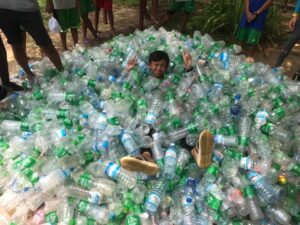 DID YOU KNOW? Although PET plastic is recyclable, fewer than 7% of PET bottles worldwide actually contain any recycled material. This is because PET bottles usually get recycled into fabric, used to make clothes, carpets and packaging. This fabric pollutes our water every time we wash it, and can’t be easily recycled, so it will end up in a landfill, or worse.
DID YOU KNOW? Although PET plastic is recyclable, fewer than 7% of PET bottles worldwide actually contain any recycled material. This is because PET bottles usually get recycled into fabric, used to make clothes, carpets and packaging. This fabric pollutes our water every time we wash it, and can’t be easily recycled, so it will end up in a landfill, or worse.
The few PET bottles that do get made into new containers can only continue in this cycle up to four times, before quality deteriorates and they also end up in landfill.
Where should it go? Landfill vs. Burning
For existing waste, Trash Hero recommends the “least worst” option available in the local area. This means the one with the least impact on human health and the environment. In most places that means proper waste separation, followed by composting, recycling if possible and finally landfill.
There are many different types of places used to dump trash and none are ideal. However we would always urge authorities to improve these facilities if needed rather than opting for incineration.
Burning plastic in any form always produces toxic emissions and wastes recoverable resources, so we never accept this as an option. The “True or False?” section has more details. In short, there is no perfect solution for existing waste: this makes it even more important to make less of it moving forward.
True or false?
As a Trash Hero you will come across many ideas on how to “solve” plastic pollution. To understand which ones will really work long term, it’s important to look at the bigger picture. Then you will be ready to answer any questions in your community and beyond.
It seems like new technologies and products are announced every month as the “solution” to the plastic crisis. It can get confusing, especially with the marketing hype that often surrounds them.
Plant plastics! Plastic-eating bacteria! Chemical recycling! Plastic as fuel! It’s hard to list them all, but these are the ones we see most often.
We assess any of these “solutions” by asking one easy question: does it reduce waste?
In other words, is it a product or process that means we will keep throwing stuff away, or does it allow us to use less and protect the Earth’s resources in the long term?
We believe a true solution to the plastic problem is one that creates a different way of making, delivering and using things so there is no waste of any kind.
The Trash Hero bottle refill programme is one example of a true solution. There are many others, but we need more and on a global scale.
A false solution will not reduce waste. Instead, it offers an alternative means of disposal or a different material to throw away. It’s usually a temporary fix.
Let’s take a look at some of the ideas mentioned above and see if they are true or false solutions.
INCINERATION
There are many types of machine that burn plastic or mixed waste and create energy or fuel that can be used for heating or transportation. They are often seen as a good solution for plastic waste, especially in areas with no place for landfills. It is even said they are better than landfills because we can “recover” the energy contained in the materials.
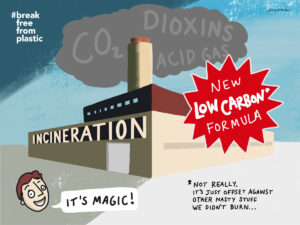 But at what cost? Many studies have shown that burning waste, even without oxygen (a method known as “pyrolysis”), is neither clean nor safe for human health. Burning plastic creates highly toxic chemicals that have been shown to cause cancer, lung disease, reproductive problems and more.
But at what cost? Many studies have shown that burning waste, even without oxygen (a method known as “pyrolysis”), is neither clean nor safe for human health. Burning plastic creates highly toxic chemicals that have been shown to cause cancer, lung disease, reproductive problems and more.
Even the most advanced machines (usually found in high income countries) cannot filter out all the dioxins and heavy metal nanoparticles released by burning. So the toxins escape into the air and the soil of the surrounding towns and villages. And up to 20% of the waste that is burned is left behind as concentrated toxic ash that must be disposed of somewhere. Which part of nature would you choose?
Health problems aside, incineration – or plastic-to-fuel, waste-to-energy or whatever we call it – does not reduce waste.
It has been shown that waste is often increased when a town starts to use an incinerator. The machine has to operate 24/7 so it needs to be fed with plastic all the time. There is then no incentive to ban single use plastic. Waste no longer needs to be sorted because it can all go into the machine. Recycling rates drop, which means resources that could be used again are burned and lost forever.
Incineration also contributes to climate change and undermines efforts to move to sustainable energy from sun, wind and water.
Verdict: a FALSE SOLUTION
BIO-BASED PLASTICS (PLA)
There are a huge range of “plant-based plastics”, which sound very natural and Earth-friendly and are often promoted as a great “alternative to plastic”. They use organic matter such as corn or tapioca instead of fossil fuel as their source material, although once produced they mainly behave in exactly the same way as fossil-fuel based plastic. Only a few types, such as the common PLA (polylactic acid), are also “biodegradable” and “compostable” at the end of their life.
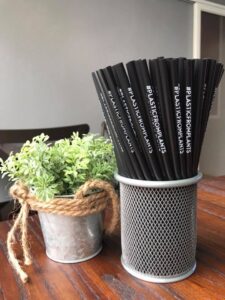 If we take a closer look at PLA’s “compostable” label, we see that composting the material is only possible in an industrial facility, where waste is heated to 60C. Here, the plastic usually breaks down into carbon dioxide and water, offering no added nutritional value to the compost. In addition, bio-based plastic contains the same chemicals used to make traditional plastic – nobody yet knows what happens to these as the plastic breaks down. In a recent study, PLA was found to contain similar levels of toxins as the highly dangerous PVC.
If we take a closer look at PLA’s “compostable” label, we see that composting the material is only possible in an industrial facility, where waste is heated to 60C. Here, the plastic usually breaks down into carbon dioxide and water, offering no added nutritional value to the compost. In addition, bio-based plastic contains the same chemicals used to make traditional plastic – nobody yet knows what happens to these as the plastic breaks down. In a recent study, PLA was found to contain similar levels of toxins as the highly dangerous PVC.
If no industrial composting is available, PLA and other biodegradable plastics must be placed in the general waste to be landfilled or burned. If placed into recycling, they will contaminate the other plastic and make it unusable.
But do bio-based plastics reduce waste? Again, the answer is no. Bio-based plastics are mainly used for disposable packaging such as straws and take-away food containers and have no useful contribution after they have been thrown away. They merely replace one single-use material with another.
Verdict: a FALSE SOLUTION
CHEMICAL RECYCLING
Most companies that produce food or household products say more or “better” recycling is the answer for packaging waste. That way, they don’t need to do anything! They can carry on producing billions of single use plastic items every day and it is up to individuals and the waste management system to deal with it.
Even if that were fair or achievable, it is not a long term solution. The quantity and the quality of material is lost every time plastic gets recycled. And after just a few cycles it reaches the end of its useful life.
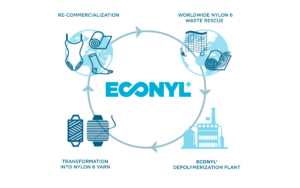
Econyl is an “infinitely reyclable” fabric
Enter chemical recycling. This is a new technology called “repolymerisation”, where plastic is broken down into its original molecules and can be used again and again to make new plastic products “infinitely”. It’s also called “plastic-to-plastic.”
While this could be a potential solution for existing plastic, it is very, very expensive to do. So expensive that it is impossible for it to compete with the price of producing new plastic directly from oil or gas. It also uses a lot more energy for the process and there is again the question of toxic emissions and waste products from the original plastic.
The European Union has said that repolymerisation technology is at least 10 years away from being commercially viable – and in the meantime new plastic production continues to grow.
Does it reduce waste? Currently, no. In theory it could extend the life of existing plastic. But the reality is that – in the best case scenario – it could help with a tiny percentage of that plastic in 10 years’ time. This makes it far less effective than reducing at the source.
Verdict: a FALSE SOLUTION
Note: sometimes the term “chemical recycling” is applied to plastic-to-fuel or other processes where the end product is burned (see “Incineration”). This may be “chemical” but it is definitely NOT “recycling”!
ZERO WASTE
The term “zero waste” covers a number of methods designed to protect finite resources and, ultimately, throw nothing away. It involves changing the whole system, starting with the producers.
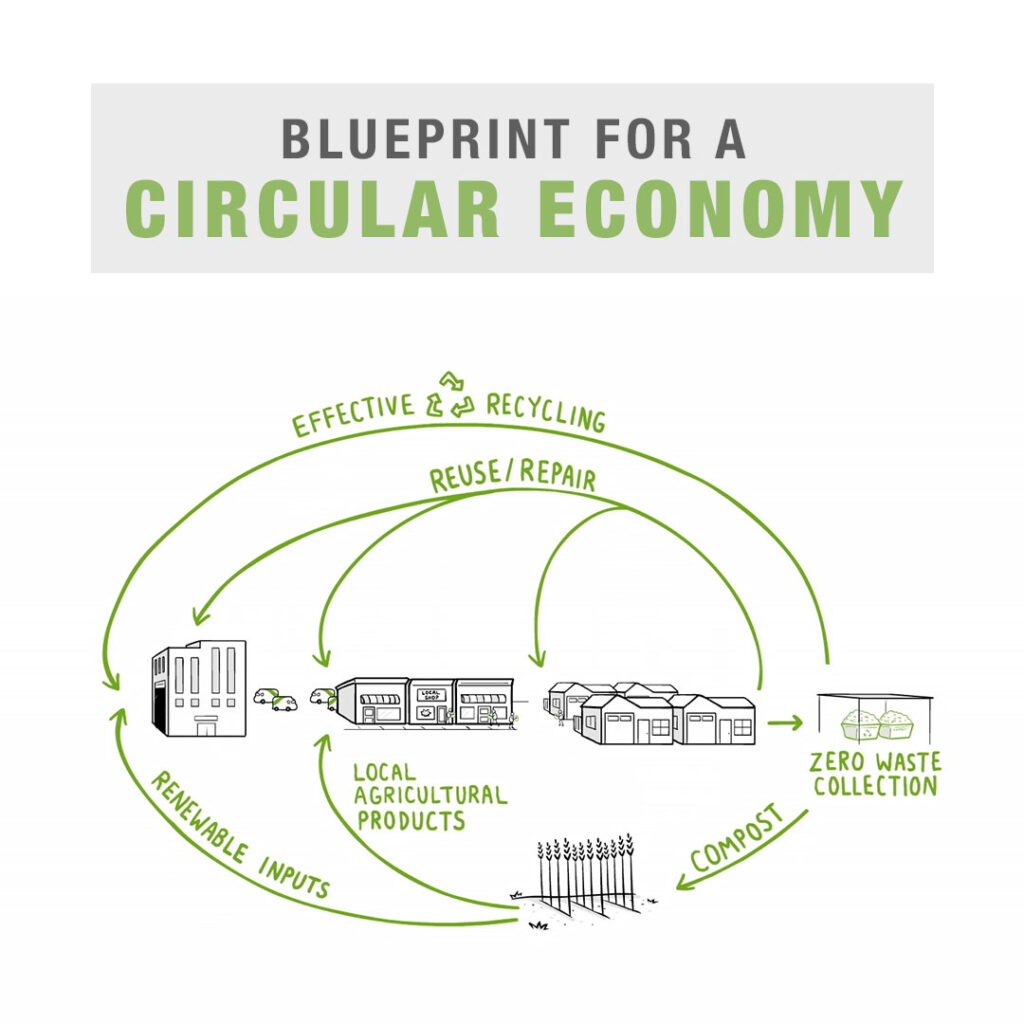
Graphic: Break Free From Plastic
Products can be designed that allow people to reuse and refill packaging and repair or replace broken parts. Materials used can be easily and permanently recycled.
Authorities can introduce waste separation systems. Food is composted; other materials cleaned then reused or recycled locally. As citizens, we can support these measures and help them to work efficiently. The small amount of waste left over can be placed into a safe landfill.
Does it reduce waste? YES! Zero waste may seem unachievable but remember: plastic didn’t widely exist 60 years ago and we can return to that way of living but with better technologies and materials. Changing the system is possible with the right momentum and as Trash Heroes we work to make this happen.
Verdict: a TRUE SOLUTION!!
To learn more about any of these topics, check out our online resource library!
4. Set up a bottle refill programme
About the programme
The aim of the bottle refill programme is to offer an affordable, practical and reusable alternative to single-use plastic water bottles, and to reduce the number of these bottles that enter the environment.
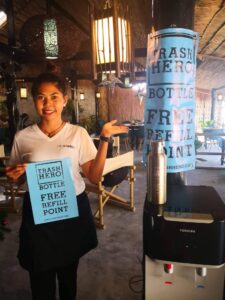 The programme provides stainless steel reusable water bottles at cost price to local businesses, who can then sell them to individual customers for a small profit. This profit is used to provide free drinking water refills for anyone with the bottle, no matter where it was bought.
The programme provides stainless steel reusable water bottles at cost price to local businesses, who can then sell them to individual customers for a small profit. This profit is used to provide free drinking water refills for anyone with the bottle, no matter where it was bought.
The programme is dependent on the support of the local community. Our partners can be businesses such as hotels, cafes, shops, bars, dive centres, or non-commercial places like community centres. The more venues that join, the bigger the refill network.
To join the programme, a partner makes the following three commitments:
- stick to a fixed selling price for all customers (for example, in Thailand this is 220 baht per bottle).
- provide free refills of clean drinking water for anyone with a Trash Hero bottle. The refill point should be easily visible and accessible for the customer.
- put up the signs Trash Hero has designed for the programme.
About the bottle
The Trash Hero bottle is made of 304 food grade stainless steel. It is single wall (no insulation) and can hold 750ml.
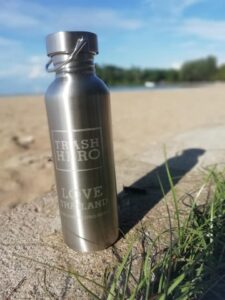 It is currently manufactured in China, while we try to find a local producer. Trash Hero has a quality and material composition certificate for the bottle available to show partners and their customers.
It is currently manufactured in China, while we try to find a local producer. Trash Hero has a quality and material composition certificate for the bottle available to show partners and their customers.
All bottles have the Trash Hero logo on the front, together with either ‘Love’ and your country (example ‘Love Thailand’) or ‘Love’ and your location (example ‘Love Koh Samui’).
Bottles can also have a company or other sponsor logo on the back – these are special orders and you can read more about these below.
Starting a bottle programme
If you would like to start a bottle programme, the first step is to contact a Trash Hero chapter in your country that already runs this programme. They can share their experience and help you get a sample bottle. If you are the first chapter in your country to start, contact your mentor team.
Finding partners
Next, it’s time to build a refill network. The easiest way to start is with places that you yourself go to regularly, or are friends with. If your team does not have any connection with potential partners, ask your social network for recommendations, or approach places with values that align with Trash Hero’s, for example an environmental product store, eco resort, green cafe, or yoga school.
Explain the objectives of the programme and make sure they understand that Trash Hero is not a business and that as such there is no profit for your chapter, or you personally. Be patient and don’t try to pressure.
We have materials introducing the bottle programme available on the intranet. The key points you will need to communicate are:
- It’s easy to trial: there is no minimum order number required for a business to start with the bottle programme.
- It’s good for sales: while they will not make a big profit from direct sales of the bottles, many businesses have reported that sales increase overall as people buy other items when coming in for refills. Certainly no partners have ever reported losing any money with the programme.
- It’s ethical: not only is the programme good for the environment, but it’s a great community service. It’s an easy way to show that they care about these issues.
- It’s free advertising: all partners will be thanked on the local chapter’s Facebook page, receive a link from the main Trash Hero website, and be listed on our global refill network map, which is publicly available online. Partners can also put their business sticker on the bottles they sell, or even have their logo engraved on the side (minimum order number required).
- It’s free social marketing: customers increasingly value businesses with good environmental practices. Many will prefer to shop or eat in places that have the programme, and will also spread the word about the business to friends or online.
Your first order
The bottles come packed in boxes, usually with 50 – 60 bottles per box. The minimum order is 1 box and any more should be ordered in multiples of the box size, e.g. 3 boxes, 10 boxes, 25 boxes. All orders must be pre-paid.
The bottles will be provided from a stock held by your national Trash Hero team; contact them to check the number of bottles per box and place your order.
These bottles have the “Love [country name]” design. If you would like to order a “Love [location name]” design on the front and / or a partner logo engraving on the back of the bottle, this is a special order, and will require a minimum number of pieces. For example in Thailand, the minimum order for custom bottles is 540 pieces / 9 boxes. So you will need enough pre-orders to cover this amount.
In the unlikely event you find a defect in any bottle after delivery, please take a picture and contact your supplier.
Storage and distribution
Assign one person on your team to be responsible for checking and keeping track of the bottle stock for your chapter, and be the contact for new orders.
At the beginning, and with small numbers, it is possible that they, or someone else on your team, will be able to keep any leftover stock at home.
With bigger orders it might be practical to look for a person or business with space to offer for free to keep the boxes. This place should be dry and away from salty air near the beach, and belong to someone whom you trust. Of course, anyone who offers help should be thanked on your Facebook page, as should new refill partners (see below).
Only deliver the bottles to your partners when you see their refill point is ready, and the signs are in place (or ready to be put up).
Bottle care also needs to be explained. If the business is located near the beach, they should only keep one sample out for display; the rest should stay boxed to protect them from salty air.
Their customers should be reminded to:
- wash the bottle regularly by hand (it is not dishwasher safe)
- rinse it with fresh water immediately after use on the beach or at sea
- only fill with cold drinks (it is not designed for hot drinks)
This means their bottle will last a lifetime.
Promoting and expanding the network
Printed materials
Trash Hero has three signs to provide to partners.
Two are general: one banner to advertise the refill station outside the business; and one poster providing information about the programme. There is a third sign specifically for hotels who would like to put the bottles in their rooms to replace the plastic drinking water bottles usually offered. The files for all signs can be sent to you digitally for local printing. Always keep the invoice and take a photo of the materials on site so Trash Hero can reimburse your costs.
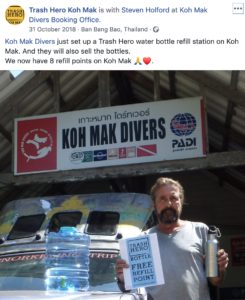 Social media
Social media
Create a post on your Facebook page to welcome and thank any new partner, with a nice picture of the bottles on site with the business owner, or a happy customer. This picture should be put into a separate “Album”, which displays all your local refill stations. Tag each business and ‘check in’.
Expand your refill network by posting information about the bottle programme and the idea behind it in local Facebook groups, as well as in regular updates on your own page.
Face to face
If you run a cleanup programme, introduce the bottles as part of your briefing, or show your team using them on the day. You might also hold an informal meeting for potential partners and invite a few existing partners who can talk about how it works for their business.
Selling the bottle through the chapter
If someone contacts you at a cleanup or elsewhere, asking to buy a single bottle, refer them to the refill partners. Don’t sell the bottles yourself or through the chapter, unless it is at a special event (e.g. conference, festival) where you are representing Trash Hero and also providing free water refills. In these cases, sell the bottles at cost price: the water refills would normally be provided by a sponsor.
Refill network map
All partners will get a free listing on Trash Hero’s global bottle refill map: trashhero.org/refill Please contact map@trashhero.org to add your chapter’s partners. It’s important to keep the map updated with any new partners who join. These businesses will get a yellow marker on the map.
It is also possible for businesses who do not sell the Trash Hero bottle but offer free water refills to be included on the map, with a blue marker. This way they can promote their eco-friendly service and we can expand the network where our bottle owners can fill up.
These businesses can sign up themselves via a Google Form and will need to provide a photo of their refill station before being added. Of course, selling the bottle and providing refills is preferable.
5. Set up a reusable bag programme
The reusable bag programme is very similar to the bottles programme. It has the same goal, to reduce single use plastic, and the same strategy, providing the products at cost to the local business community so they can sell for a small profit.
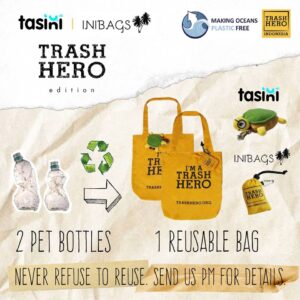 About the bag
About the bag
Trash Hero reusable shopping bags are yellow, with the words “I’m a Trash Hero logo” on the front. It is handmade in Indonesia from recycled plastic [rPET] material – the equivalent of 2 x 500ml water bottles. It measures 35cm x 40cm, and folds into a pouch, in two designs – plain with a logo or a cute turtle. Both come with a handy metal clip.
About the programme
Bags are provided at cost to our partners, who can sell them with a small profit, or give them free to customers instead of a plastic bag. Some hotels attach them to room keys, so that their guests always have a reusable bag with them during their stay. They also go very well together with the bottle: they can be clipped on to the cap and sold as an “eco-package” to reduce waste.
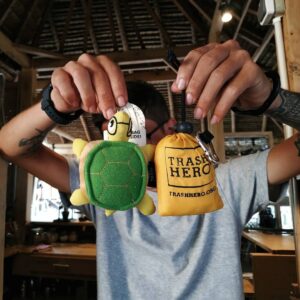 How to order
How to order
In the first instance, contact your mentor team: your country may have some bags in stock. If a new order is needed, there is usually a minimum number required, which they can tell you. You might be able to split a new order with a chapter close by, or get sponsors. For businesses who place a large order, it is possible to get their logo printed on the reverse of the bag. For further questions, please contact bag@trashhero.org
6. Involve kids
 Children, young people, and their families are a vital part of our movement. We have created general education materials, as well as a structured kids’ programme that chapters can use to get them involved.
Children, young people, and their families are a vital part of our movement. We have created general education materials, as well as a structured kids’ programme that chapters can use to get them involved.
Keeping kids safe
It is very important to make sure that children participate in our activities in a healthy and safe way. You and your team must read and agree to follow the Trash Hero code of conduct included in our child protection policy.
Education materials
We have a dedicated section on our website for kids. This is aimed at 8 – 10 year olds, but also suitable for younger children with reading help. You’ll find information, videos and quizzes to engage children on the issues and photos and work from other Trash Hero kids around the world to inspire them. If you have any good stories or photos from your own chapter to add here, please let us know at kids@trashhero.org.
Info posters in multiple languages are also available to download and print.
Trash Hero Kids’ Programme
We started “Trash Hero Kids” in 2018, after seeing how much children loved to take part in our cleanups and be heroes for the day. It is a structured, long term programme to help children from 5 – 10 years old understand the problem of waste and adopt environmentally friendly practices in their daily lives. As is usual with Trash Hero, the learning process is designed to be light, positive and hands-on.
At the heart of the programme is the specially designed kids’ book. It is available in multiple languages, including English, German, Czech, Thai, Indonesian, Burmese and Malaysian.
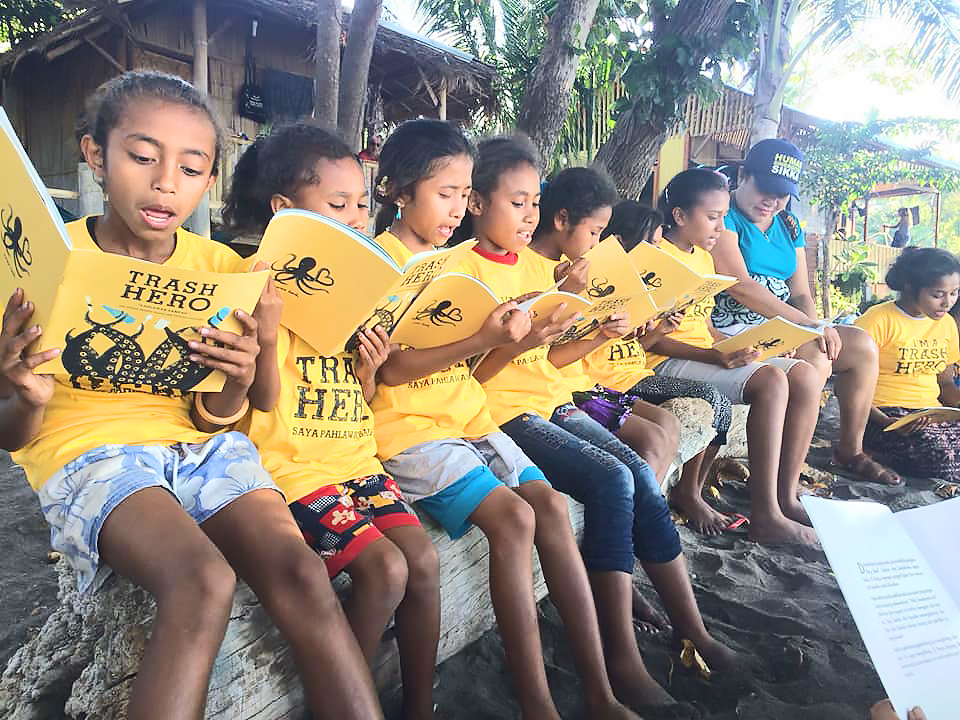
The book starts with a story about a child called Trash Hero, which introduces the issues of waste and plastic pollution in a simple and relatable way. It explores how our everyday behaviour has an impact on the environment and shows how each child has the power to change the situation.
Following the story, there are facts and information about ocean plastic and what happens to our waste. These can form the basis of a discussion on different aspects of pollution and the “3 Rs” (Reduce, Reuse, Recycle).
Finally, the book challenges the children to take action and become a Trash Hero themselves. There are seven tasks set that can be done repeatedly to create positive habits. Each time they complete a task, the children record their success and collect points to win rewards such as a Trash Hero t-shirt and a certificate.
The kids’ programme can be run in one of two ways: within your chapter with kids who regularly attend your cleanups; or in conjunction with a local school or community group where the teacher is able to commit at least one hour per week to the topic. It is not designed for one-off events*.
We have guidelines available for teachers in local language. Often there will be mentors in your country who can provide additional support. If you have time, you should try to present at least one session at the school. Or, you could host the kids at your cleanup, which is one of the tasks they need to complete in the book.
The kids’ programme is one of the most rewarding activities you can do as a volunteer but it will also take a significant amount of your time to organise and supervise. You will need to do some extra reporting, as Trash Hero provides all the materials required – book, t-shirt and certificate – for free. Please be sure you can make this commitment before starting to avoid disappointed kids!
Chapters who have their yellow logo may apply to run the programme; please contact your country coordinator or kids@trashhero.org for further information.
*For one-off events and presentations involving kids we have PDF versions of the book available on our website. Most of the challenges can be adapted and some chapters have had success getting the children to do a staged version of the story as part of the activities.
7. Engage the wider community
The problem of waste can only be solved long-term if you engage your community and inspire behavioural change. The community should feel they are a part of Trash Hero and see our mission as their own. Here are some ideas for how to achieve this:
Work with the local business community
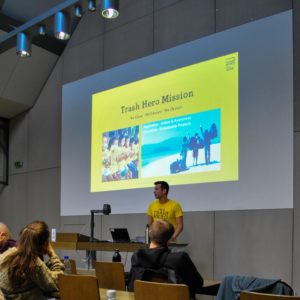 There are often hotel or trade association events where you can do presentations and show companies how to take action. Ask if they would send a communication to their members to introduce Trash Hero and invite them to send staff to cleanups or provide services for you.
There are often hotel or trade association events where you can do presentations and show companies how to take action. Ask if they would send a communication to their members to introduce Trash Hero and invite them to send staff to cleanups or provide services for you.
Larger hotels or companies can be approached directly: they will often have CSR commitments to fulfil and be grateful for the opportunity to join you.
Motivate businesses to lead by example and celebrate them as local champions on social media. For example if a restaurant stops using plastic straws, or gives customers a discount for bringing their own cup for takeaway drinks, post it on social media so other businesses are inspired to follow their example.
Create a closed chat group (Line, WhatsApp, Messenger, or whatever is appropriate in your location) with all interested business owners and sponsors of your projects. Inform them frequently about your activities. This is also your platform to ask for support.
Take the lead and organise your own meetings or workshops at a neutral venue where everyone in the community is invited to join and discuss “how to make our home cleaner”. Do not exclude anyone, stay independent and politically neutral and don’t become associated with any business or group of businesses. It’s important to build up a big and wide network of sponsors and supporters.
Some businesses may want to sponsor more than you need for your activities. Be creative and find ways to accept the help. A resort could order 100 Trash Hero t-shirts for you to give away for free, or a spa could offer one free massage every week for a volunteer that joins a Trash Hero cleanup (hold a prize draw at the end for the winner). As long as there is no money involved, there is no problem with that.
“Build a big and wide network of supporters”
Work with other environmental groups
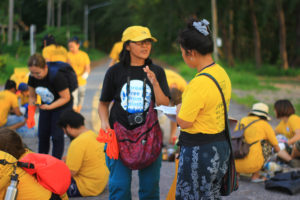 Collaborate with other non-profit organisations or environmental projects in your area or globally. We are not in competition with anyone: only by working together can we make a difference.
Collaborate with other non-profit organisations or environmental projects in your area or globally. We are not in competition with anyone: only by working together can we make a difference.
For example:
– Do a brand audit at your cleanup and provide data for organisations such as Break Free From Plastic.
– Hold joint events, or at the very least coordinate your activities so you are not cleaning on the same days or the same place every time.
Work with government agencies
Introduce your Trash Hero chapter to different agencies and invite them to join your activities. Make sure they understand that Trash Hero will not publish any bad news, nor point fingers at anyone. Neither do we show the local area in a bad light: we show people cleaning together and doing good things. We are just here to help. Never get directly involved in local politics.
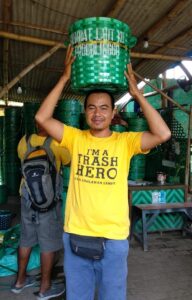 If you have a good relationship with your local government, you could try to improve existing trash collection by bringing the right people in the community together to discuss and implement solutions, for example by providing more public garbage bins.
If you have a good relationship with your local government, you could try to improve existing trash collection by bringing the right people in the community together to discuss and implement solutions, for example by providing more public garbage bins.
Businesses could sponsor this with materials and pay staff to empty them, in return for some advertising on the bins. Or, you could get local artists or schools to paint or design the bins and the government might agree to empty them.
Most important is that the whole process is transparent and if money is involved than everything needs to be posted on social media and shared with the community to prove that Trash Hero is not making any profit. Remember to present your ideas in a positive way and not show anger or blame anyone if they are not implemented. Working with the government takes time; this is normal.
Get involved in local festivals: advise organisers how to go zero waste or place more garbage bins around the area. Help them to organise a cleanup event with their staff afterwards but make sure they also make commitments to improve their waste management during the festival.
Note that any kind of collaboration requires people working together. You may find people call you to come and clean up an area that is dirty – this is not collaboration! There should be a joint effort: for example, if a business provides volunteers or other resources for the cleanup and agrees to provide bins once the area is clean. It is important that Trash Hero is not seen as an on-call cleanup service.
8. Use social and traditional media
Why use social media?
Social media is the most important tool of external communication for your chapter.
Your chapter’s social media presence is your public “image” and your “voice”: you control what is posted, and how your chapter is seen.
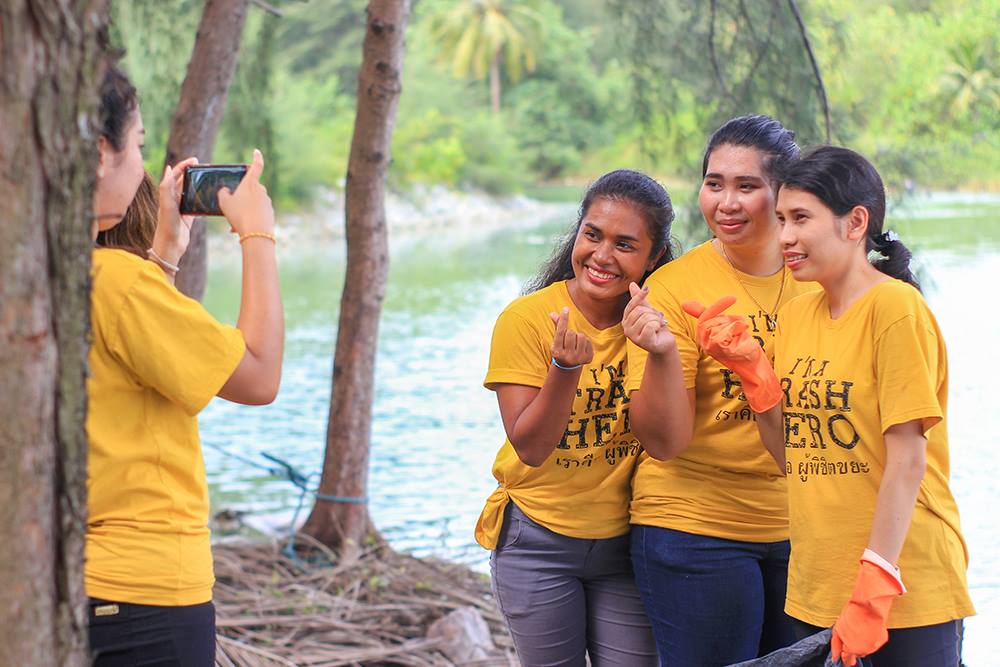
It serves several purposes, to:
ENGAGE
– show your actions to the local community and gives credit to your partners, sponsors or organisations you cooperate with
– build bridges among your community, especially if posts are bilingual
– connect with people and share information through the page and local groups
INSPIRE
– show that you are part of the countrywide and worldwide community of Trash Hero by sharing inspiring posts from other chapters
– encourage small actions by showing the wider impact: local issues or actions can be connected to global problems and vice versa. This spreads the message that every action and every person counts… together we make a difference!
INFORM
– keep your community up to date about new projects and achievements
– show transparency. This is a very important part of Trash Hero
– keep a record of your photos and numbers for Trash Hero World’s database
SHOW APPRECIATION
– make sure sponsors and volunteers are publicly acknowledged and thanked
– tags and check-ins give free advertising for businesses that are taking action on waste
Social media is also a great tool for internal communication which helps to build your local network:
Use Messenger / Line / WhatsApp to create chat groups with, for example, sponsors, bottle partners, the chapter team and regular volunteers. This way, you can create a community feeling, spread information fast, get feedback and ask for support.
If you can, tag people – for example on the group pictures of your cleanup. This will usually spread the reach of the photo beyond your “fans”, to that person’s friends. Once connected to people, ask them to follow your page or account, or send them personal invites to your cleanup and any other events.
What and how to post?
For Trash Hero, the most important thing is to post positive and optimistic information. Keep it relevant, with a local reference if possible, and ensure there is no political content. Post pictures and videos, and try to add any text in both local language and English. There is no need for perfection – the most important is that you tell your stories! Here are a few ideas about what to post:
- Your cleanups should always get a new Album and post on Facebook (see: Cleanups)
- Advertise any other event or action you do – make sure you show happy, smiling people!
- Thank sponsors for their support, no matter how small
- “Meet a Trash Hero” – a short interview and photo of one of your team or cleanup volunteers explaining why they joined Trash Hero
- Provide information about your bottle or bag programme, and any new partners
- Support other similar groups in your area, for example by sharing their cleanup event.
- Share posts from other Trash Hero chapters or countries
- Share news articles or videos about waste and plastic pollution, with a text to show its local relevance. Avoid purely negative images or messages.
If for any reason, you have no ‘news’ to share, why not post a beautiful sunset picture? Celebrating your area’s beauty reminds everyone why we should keep it clean.
Aim to post at least 2 or 3 times a week, but not more than one post per day.
Facebook has tools to help you stay organised: for example, you can “schedule posts” to publish automatically at a set time; use an “event” post to promote your cleanups; and use “photo albums” to create separate sections for your cleanup diary, sponsor portfolio, network of refill stations etc.
Basic rules for communication
When your page starts to engage the local community, you will get comments and messages on your posts. Not all will be encouraging. Remember the following when you answer any comments:
Trash Hero does not point fingers. That means we do not blame or make people feel guilty.
Don’t be drawn into arguments. It doesn’t lead anywhere. Rather respond in a nice, friendly way, concentrating on Trash Hero’s mission and facts.
Keep all communication polite and optimistic.
Beyond the Facebook page: other channels
Facebook is our main focus. However, we are also active on Instagram and your chapter may use this, Twitter or any other local social media channel. Please inform your mentor team if you want to open any new social media account, and follow the same guidelines for posting as noted above.
On YouTube, Trash Hero World has its own channel, and we also have a few country-based channels. We prefer chapters to share their videos via these channels rather than open their own. If you have a great clip to share, contact your mentor team and they will upload it to one of our YouTube channels, and credit your chapter.
Approaching and talking to the traditional media: TV, newspapers etc.
Media coverage is great because it helps to spread the word about Trash Hero. But it can be risky, as we are not always able to control how our activities are presented.
It’s a good idea to contact the local media (TV, newspapers etc.) soon after you start your chapter. Build a good relationship with them, inform them about special events and invite them to join. Once you grow your network, the national and international media may also contact you directly.
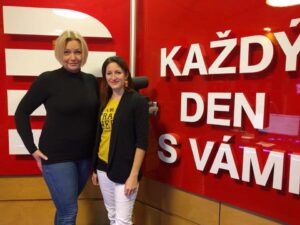 If you are contacted by any external media (TV, blog, magazine) to give an interview, make sure they are clear in advance what Trash Hero is about and our positive, inclusive approach. It’s also useful to check what their intended message for the piece is before you agree. For example, we found a local news outlet who wanted to focus on the couple of foreigners they saw at a cleanup, to try and “shame” local residents that westerners were cleaning their beaches, instead of recognising that there was a whole community effort taking place.
If you are contacted by any external media (TV, blog, magazine) to give an interview, make sure they are clear in advance what Trash Hero is about and our positive, inclusive approach. It’s also useful to check what their intended message for the piece is before you agree. For example, we found a local news outlet who wanted to focus on the couple of foreigners they saw at a cleanup, to try and “shame” local residents that westerners were cleaning their beaches, instead of recognising that there was a whole community effort taking place.
During any interview, wear your Trash Hero t-shirt – even if you are on the radio! It will give you confidence and look good on any photos you take to post later. No matter what you are asked, be positive and always be sure about what you say (don’t make wild claims under pressure!).
Redirect questions about who is to blame for the trash etc. towards the positive: “that’s not something we feel is helpful; we concentrate instead on bringing people together and finding solutions…” And don’t feel you have to give a reply to all questions: “I don’t know” is a valid answer.
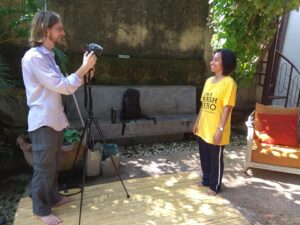 If you feel nervous, try to relax. You don’t have to be a professional spokesperson, just answer from your heart, and stick to things you know to be true. You could also prepare by watching existing media clips and reading articles from other Trash Hero chapters before you, to see how they handled it.
If you feel nervous, try to relax. You don’t have to be a professional spokesperson, just answer from your heart, and stick to things you know to be true. You could also prepare by watching existing media clips and reading articles from other Trash Hero chapters before you, to see how they handled it.
If you have written questions to answer, this should be easier: there is general information about Trash Hero on the website, and also in this document, that can help you.
After any interview, ask to see the final piece before it is published / broadcast. This may not always be possible, but it is important to ask: bad press can damage not only your reputation locally but all Trash Hero groups worldwide. If you do see the piece and are unsure about the result, contact your mentor team to authorise it.
Share all media coverage on your social media channels, with a link if available. Please also send the information to your country team and Trash Hero World so we can post it on the website.
“Whichever channel you use, always keep your communication polite and positive.”
9. Get sponsors
Local support is key to the success of your chapter. Sponsors should come from your community, and everyone should have a chance to participate. The small businesses are as important as the big ones.
If someone on your team owns a business, it can be convenient to use that to sponsor all activities at the start. But please don’t! It is essential no business is directly connected with Trash Hero. For example, this business could sponsor a cleanup from time to time, but should not be the regular or only sponsor, and their shop should not be the meeting point. Other people won’t get involved with Trash Hero if they think it is an activity to promote your business, or that you take personal advantage from it.
 How to approach businesses
How to approach businesses
Use your network to find contacts. Having a recommended person you can approach within a business makes it easier for you to connect. Depending on the size and location of the business, you can make the first contact by email, phone or in person.
If you go in person, and you don’t have a contact name, ask to speak directly to the manager or owner. If they are not available, arrange a face to face meeting later (this should always be done if you call or email). Wear your yellow Trash Hero shirt so you are neutral and not representing any business in the area.
Prepare yourself well: can you explain Trash Hero’s mission and approach in two minutes or 10 minutes? You don’t know how much time you will get. Be very specific about how the business can get involved in your actions and what kind of support you need.
 Do not ask for too much help in the beginning. Businesses can first donate a little bit and once they are happy they will help more. For example: ask for 30 garbage bags or some fruit for the next cleanup.
Do not ask for too much help in the beginning. Businesses can first donate a little bit and once they are happy they will help more. For example: ask for 30 garbage bags or some fruit for the next cleanup.
Once you build trust, try to make an agreement with a business to get support on a regular basis. For example: Resort A provides free food after the cleanup for volunteers once per month. This will also help you in your planning.
Make sure you do not accept any general money donations, and that they know that you are a volunteer. If you have time, show a few pictures from Trash Hero on a phone or laptop, or even prepare a short presentation. Always give them your contact details, and the website / Facebook address so they can find out more if interested.
For general sample presentations, you can ask on the intranet. Your mentor team, or other local chapters may have email templates that you can use and modify, for example:
– a letter to introduce the Bottle Project
– an invitation to join a cleanup with staff
You can contact other chapters via the intranet.
Stay in touch with your sponsors
Keep your sponsors informed about your activities and make sure everyone knows the results are thanks to their support. For example, put them all in a Line or WhatsApp chat, or send them a regular email with your updates, your needs and any receipts to show that you are transparent. You can also involve government agencies in that chat, or other partners / non profit organisations.
Stay positive
Some businesses need longer to understand what Trash Hero is about. So it is also normal that at first many may not want to get involved. But there is always someone who will support you, and once you start to show your actions on social media and everyone is happy you will see that others will change their minds. Unfortunately you might also find people who are very negative or disrespectful to you personally or to Trash Hero in general. Please remember to stay happy and positive and that there is always hope 🙂
Note: If you have sponsors who would be willing to support the global movement with a donation please inform your country team or Trash Hero World about it. Money donations cannot be accepted by local chapters.
10. Manage volunteers
Increase participation
Even after you are set up, it is important to keep increasing participation in Trash Hero activities.
– Keep your core team and all activities open to newcomers
– Advertise for team volunteers on social media – both your own channels and any local groups
– Ask people to bring friends along to cleanups
– Distribute posters to new places, ask local media if they would consider placing a free ad for your cleanup, or get a dive school to show a Trash Hero video in their shop or boat.
Be creative!
Provide training
As you get more experienced, pass that knowledge on. Give your regular volunteers extra responsibility for some tasks to keep them engaged, and also to lighten your own load. For example, they could distribute cleanup posters, or do the photography at the cleanups.
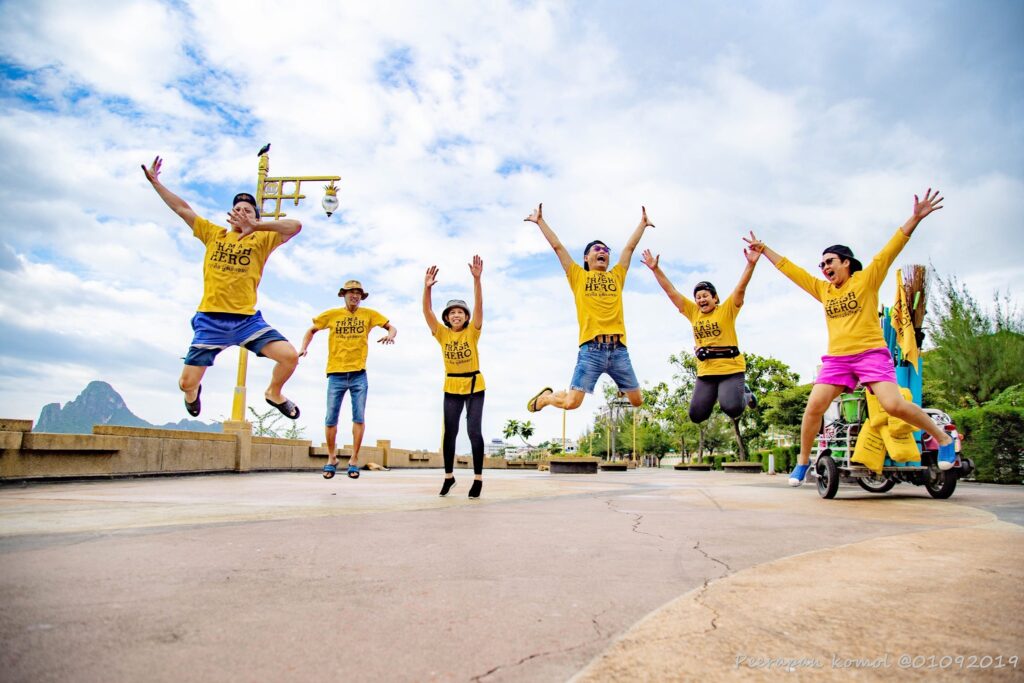
Keep celebrating
As time goes on, it is tempting to spend less time celebrating your actions. But this is so important to motivate volunteers. Check if you have an “anniversary” coming up — maybe 50 cleanups, or your chapter’s birthday. Plan a cleanup in a special location, or a special sponsor who might provide a cake or a prize for the volunteers afterwards.
Manage conflict
Occasionally you may find people who are critical of either your team or Trash Hero in general. This is often because they do not agree with our approach, or think they can get better “results” by doing things differently. In these – or any – cases of conflict, it is important not to get angry, sarcastic, or personal in your response, as this will escalate the problem.
If the comments are made online in public, try to take the discussion into a private channel or, even better, offline. A face-to-face conversation or phone call often helps to defuse the situation and avoids misunderstanding. In general it is better not to delete comments unless they are personal attacks or contain hate speech.
In any discussion, actively listen and try to understand what the issues are, and explain our policy in relation to them – refer to these documents for the “official guidelines”. Be respectful of all viewpoints, and any emotions expressed.
If you need help resolving a conflict or drafting a response, contact your mentor team or ask for advice via the Trash Hero Family intranet.
11. Don’t give up!
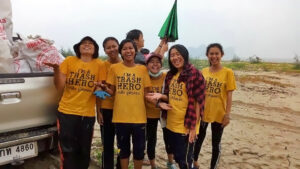 The road towards making a positive impact can be littered with frustration, disillusion, boredom, or even fear. Remember that you have the big family of Trash Hero behind you and that removing litter is what we do best 😉
The road towards making a positive impact can be littered with frustration, disillusion, boredom, or even fear. Remember that you have the big family of Trash Hero behind you and that removing litter is what we do best 😉
Believe in the mission, believe in yourself and accept it takes time to start and change things.
Dealing with negativity or criticism
Trash Hero is very visible within communities and most people will have an opinion about it. The majority of voices will be positive and encouraging; a few will be critical, dismissive or even attacking. It helps if you try not to focus on the negative, or take criticism personally.
Stay neutral and friendly. Maybe the person hasn’t really understood the approach of Trash Hero, or that we are all volunteers.
On the other hand, take feedback seriously and try to understand others’ position or even anger. In the case of a direct conflict, show you are listening. The sentence ‘I understand you, but we take a different approach’ can often calm down the situation.
If you have a constantly negative person in your team, talk openly to them and look for a solution together. Maybe they feel their contribution is not being recognised, or maybe in the end their views are better suited to another, more political organisation.
If you need to get advice about any situation, consult with your chapter team, the mentor team, or other Trash Hero chapters as appropriate.
Dealing with lack of sponsors or volunteers
Maybe it’s “low season”, or maybe you are losing momentum, but you notice sponsors are less responsive and fewer people are showing up to cleanups. Or, you’ve just started and are getting frustrated by the lack of community support.
It takes time for people to understand what Trash Hero is, and to build up trust. It also takes work to keep it going, week after week. Be open with your team about this and be creative in finding solutions. You may get new ideas by brainstorming together, or by contacting your country chat group.
Keep in mind also that success is not just measured in numbers! Try to notice and celebrate more subtle effects of your impact. These can give you a boost.
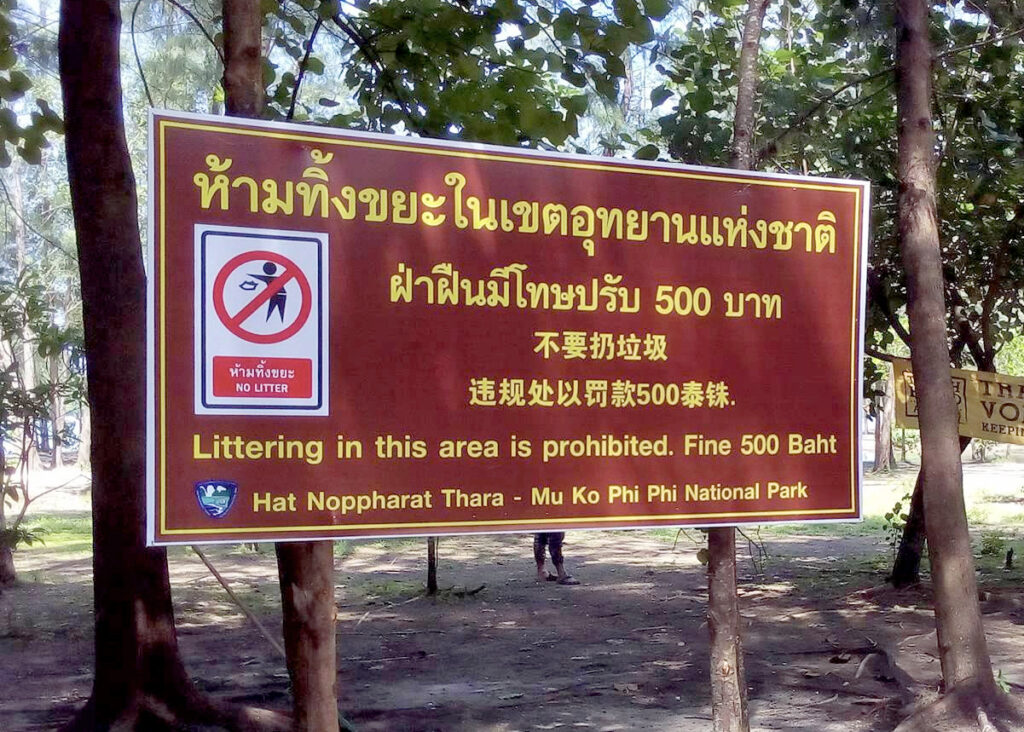
For example, after working several weeks doing joint cleanups with the Department of National Parks, one Trash Hero chapter found new signs had been put up at the headquarters. The signs had changed from “US$15 penalty for littering” (above) to a softer, more positive message (image below): “Let’s join together to solve the trash problem – if you can do this, you are a hero!”.
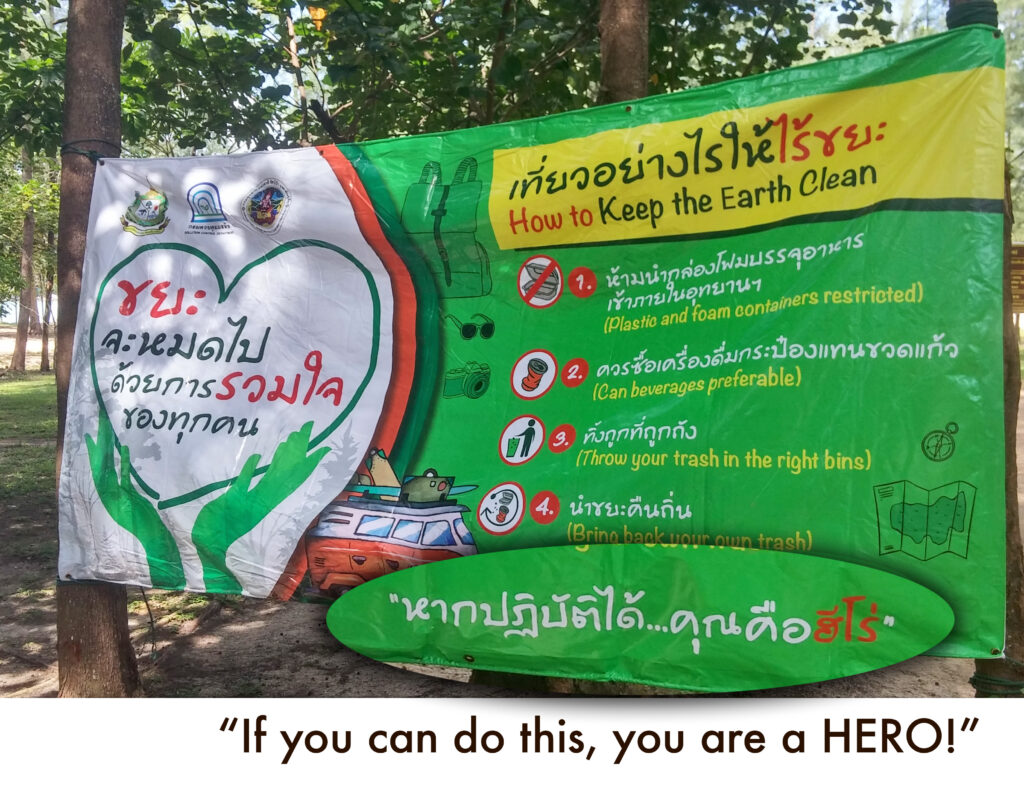
Look for these small changing attitudes around you: even if you cannot take all the credit, it is wonderful to see, and they are worth just as much as volunteer numbers.
Dealing with stress or fatigue on your team
Problem: There are many tasks you have to get done in a short time with not many people.
Solution: Sit down together and have a close look again… can tasks be combined? Is this task necessary at this moment? Prioritise and focus on one or two.
Problem: A task becomes a burden or boring after a while.
Solution: See if you can swap with someone in your team, or invite other people to take it on with a Facebook post or mentioning it at your next clean-up.
Problem: You feel super enthusiastic and want to launch many projects, or get involved in other local actions, all at the same time.
Solution: Focus and slow down! Of course you want to get many things done, quickly and in the best way. But concentrate on getting your initial idea and project right, and the rest will follow.
Problem: You feel like you have been working non-stop for Trash Hero, and your own work is suffering, or you feel a bit burned out.
Solution: Simply take a break! Stop cleanups for a week or two, take a couple of days’ holiday, or limit your time to certain ‘Trash Hero days’ in the week. This is not a failure in any way, it is necessary — and you’ll come back with more energy, ideas and enthusiasm again.
Remember, you are not alone with these kind of experiences. Stick to the Trash Hero approach, be patient with yourself and those around you, and get feedback or advice. The great thing about Trash Hero is that we can — and do — talk openly to each other.
12. Support the wider Trash Hero mission
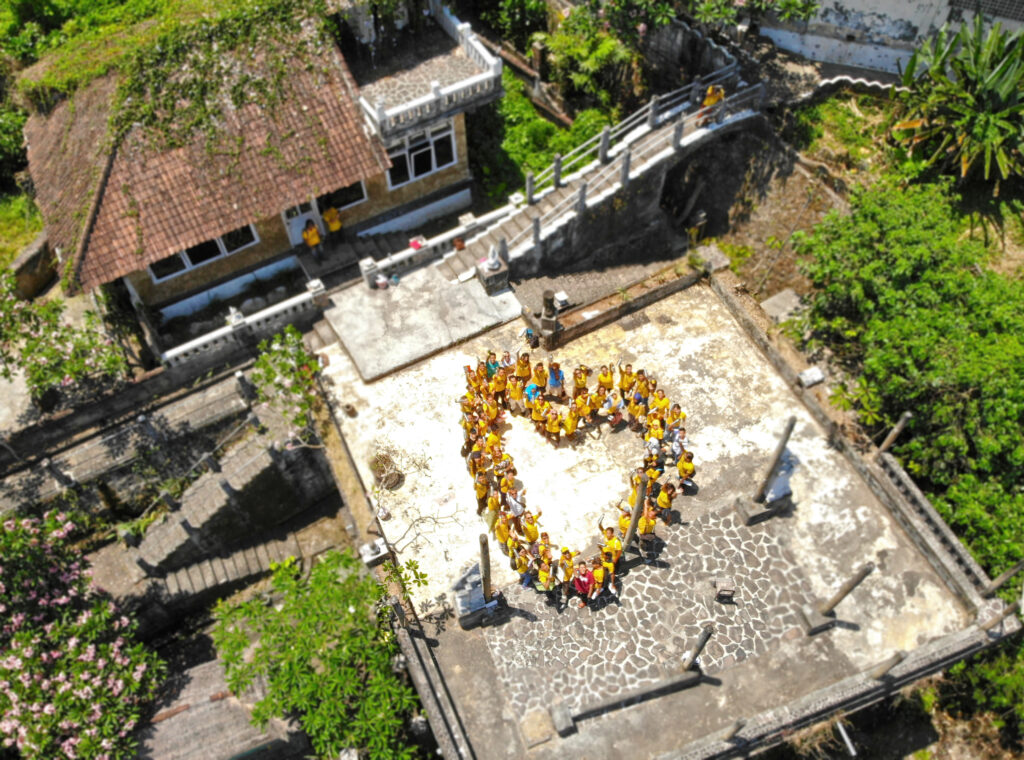
As a Trash Hero you are part of our family network and help us to spread the message around the world. Being a good role model is important: your actions reflect on all of us, and your attitude can inspire others to join. New Trash Hero chapters are often started after people join a cleanup in one place and want to take the idea back home.
Things you can do to help the network to grow and become stronger include:
- Share your stories with your country or the world organisation. You can do this by tagging them on a social media post, emailing them or sharing on the Trash Hero Family intranet.
- Participate in discussions on the intranet, share your experience and provide your help.
- Always set a good example, as you reflect on the wider organisation. For example, try to refuse plastic wherever possible and not use any plastic straws, bags and bottles in your daily life.
- In countries where a lot of chapters are active, we organise Trash Hero Family Meetings twice a year to share experiences and learn from each other. Try to join these – it’s a great way to get to know your fellow Trash Heroes and get motivated for future projects.
- Once you get more experience you may want to get involved in the mentor team and help to start and support other Trash Hero chapters.
- Follow our brand guidelines when creating materials for your chapter. It is essential that the Trash Hero brand is professional and consistent, and our design team will help you to achieve this.
- If you have contacts or friends that want to help Trash Hero but cannot help in your location, please direct them to our website. Skilled volunteers for the global organisation are always welcome!
Together we make a difference! And if you are still reading this, you are a true hero 😉
Anything to add?
We have tried to make this handbook as comprehensive as possible.
However, if you find anything missing, or would like to make a suggestion for the next edition, please submit your feedback to us.
For questions relating to the running of your chapter, always contact your mentor team in the first instance. Thank you!

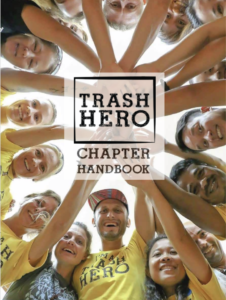
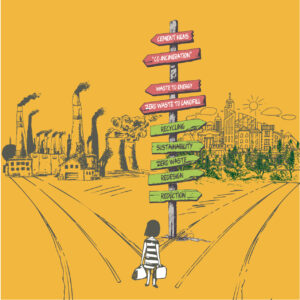
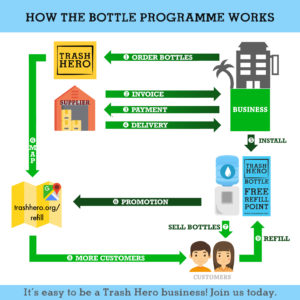
1 comment
Join the conversationa jeevandas - 26/03/2021
happy to have an opportunity to be a mentor of organizing chapters in india